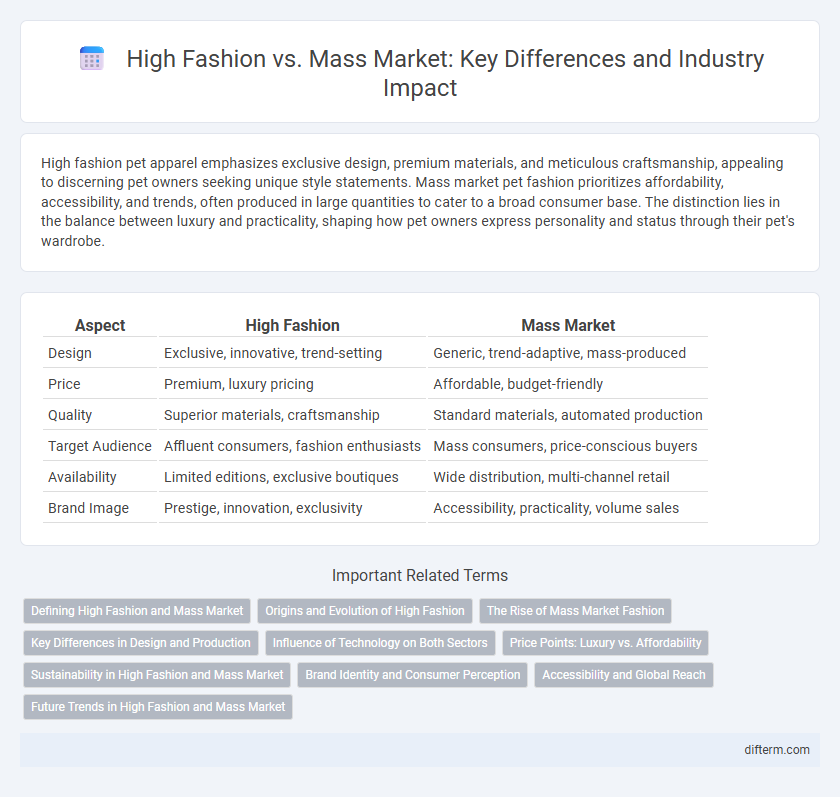High fashion pet apparel emphasizes exclusive design, premium materials, and meticulous craftsmanship, appealing to discerning pet owners seeking unique style statements. Mass market pet fashion prioritizes affordability, accessibility, and trends, often produced in large quantities to cater to a broad consumer base. The distinction lies in the balance between luxury and practicality, shaping how pet owners express personality and status through their pet's wardrobe.
Table of Comparison
| Aspect | High Fashion | Mass Market |
|---|---|---|
| Design | Exclusive, innovative, trend-setting | Generic, trend-adaptive, mass-produced |
| Price | Premium, luxury pricing | Affordable, budget-friendly |
| Quality | Superior materials, craftsmanship | Standard materials, automated production |
| Target Audience | Affluent consumers, fashion enthusiasts | Mass consumers, price-conscious buyers |
| Availability | Limited editions, exclusive boutiques | Wide distribution, multi-channel retail |
| Brand Image | Prestige, innovation, exclusivity | Accessibility, practicality, volume sales |
Defining High Fashion and Mass Market
High fashion, also known as haute couture, is characterized by exclusive, custom-fitted clothing crafted by luxury fashion houses such as Chanel, Dior, and Gucci, emphasizing creativity, craftsmanship, and limited production runs. Mass market fashion targets a broad consumer base with affordable, trend-driven apparel produced on a large scale by brands like H&M, Zara, and Uniqlo, prioritizing accessibility and rapid turnover. The distinction lies in the level of personalization, quality of materials, design innovation, and pricing strategies defining the consumer experience and brand positioning.
Origins and Evolution of High Fashion
High fashion, also known as haute couture, originated in 19th-century Paris, rooted in the exclusive ateliers of designers like Charles Frederick Worth, who established the first haute couture house. This elite sector evolved through meticulous craftsmanship, custom fittings, and limited productions, distinguishing itself from the mass market's focus on affordability and large-scale manufacturing. Over time, high fashion has influenced mainstream trends while maintaining its status through innovation, luxury materials, and artisanal techniques.
The Rise of Mass Market Fashion
The rise of mass market fashion has revolutionized the industry by offering affordable, trend-driven apparel to a broader audience, challenging the exclusivity of high fashion. Fast fashion brands like Zara, H&M, and Uniqlo dominate global retail markets with rapid production cycles and competitive pricing. This shift emphasizes accessibility and volume over couture craftsmanship, reshaping consumer expectations and accelerating trend dissemination worldwide.
Key Differences in Design and Production
High fashion emphasizes exclusive, avant-garde designs crafted through meticulous handwork and limited production runs, resulting in unique, high-quality garments. Mass market fashion relies on standardized designs produced in large quantities using automated processes, prioritizing affordability and trend replication. The key differences lie in material quality, production speed, and target consumer exclusivity.
Influence of Technology on Both Sectors
High fashion leverages cutting-edge technology such as 3D printing and AI-powered design tools to create innovative, bespoke collections that set industry trends. In contrast, the mass market employs advanced manufacturing automation and data analytics to rapidly produce affordable, on-trend apparel that meets broad consumer demand. Both sectors benefit from digital platforms enhancing supply chain efficiency and customer engagement, driving dynamic shifts in fashion consumption patterns.
Price Points: Luxury vs. Affordability
High fashion brands emphasize exclusivity and craftsmanship, with price points often exceeding thousands of dollars per item, reflecting luxury and prestige. Conversely, mass market fashion targets affordability and accessibility, offering trendy pieces typically priced below $100 to appeal to a broad consumer base. The stark contrast in pricing embodies differing value propositions, with luxury emphasizing quality and heritage, while mass market prioritizes volume and cost efficiency.
Sustainability in High Fashion and Mass Market
Sustainability in high fashion often involves the use of premium, eco-friendly materials and artisanal craftsmanship that prioritize environmental ethics over volume, resulting in limited, high-quality collections. In contrast, the mass market faces challenges due to large-scale production and fast turnover, often relying on synthetic fabrics and less rigorous sustainability standards. Innovations like recycled textiles and circular design models are increasingly adopted across both sectors to minimize environmental impact and promote responsible consumption.
Brand Identity and Consumer Perception
High fashion brands cultivate a distinct brand identity through exclusive designs, craftsmanship, and heritage, attracting consumers who value uniqueness and prestige. Mass market brands prioritize accessibility and trend responsiveness, shaping consumer perception around affordability and widespread appeal rather than exclusivity. Consumer perception in high fashion emphasizes luxury and status, whereas mass market focuses on practicality and trend alignment, influencing purchasing behavior accordingly.
Accessibility and Global Reach
High fashion brands often prioritize exclusivity and limited availability, creating unique, high-quality pieces that appeal to niche markets. Mass market fashion emphasizes accessibility by producing affordable, trend-driven clothing available worldwide through extensive retail networks and online platforms. This global reach allows mass market brands to influence a broader consumer base, while high fashion maintains prestige through selective distribution and craftsmanship.
Future Trends in High Fashion and Mass Market
Future trends in high fashion emphasize sustainability, with designers increasingly adopting eco-friendly materials and artisanal craftsmanship that cater to luxury consumers seeking exclusivity. Mass market fashion is rapidly integrating AI-driven personalization and fast production cycles to meet demand for affordable, trend-responsive clothing. Both sectors are converging on digital innovation, with virtual fashion shows and augmented reality shopping experiences reshaping consumer engagement.
high fashion vs mass market Infographic

 difterm.com
difterm.com